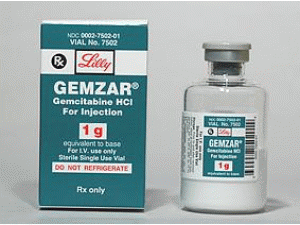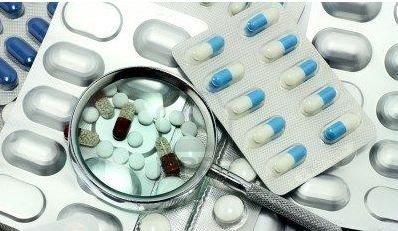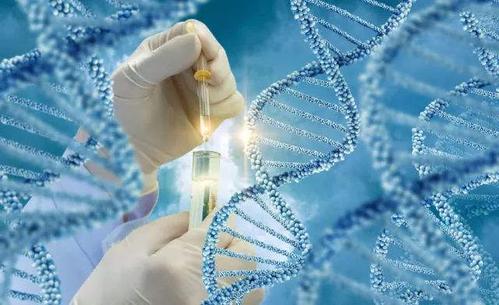盐酸吉西他滨冻干粉注射剂(Gemzar 1g)
 产地国家:美国
处方药:是
所属类别: 1克/瓶
包装规格: 1克/瓶
计价单位:瓶
生产厂家中文参考译名:无
生产厂家英文名:Eli Lilly
原产地英文商品名:GEMZAR Injection 1g/Vial
原产地英文药品名:Gemcitabine Hydrochloride
中文参考商品译名:健择注射剂 1克/瓶
中文参考药品译名:盐酸吉西他滨
曾用名:无
产地国家:美国
处方药:是
所属类别: 1克/瓶
包装规格: 1克/瓶
计价单位:瓶
生产厂家中文参考译名:无
生产厂家英文名:Eli Lilly
原产地英文商品名:GEMZAR Injection 1g/Vial
原产地英文药品名:Gemcitabine Hydrochloride
中文参考商品译名:健择注射剂 1克/瓶
中文参考药品译名:盐酸吉西他滨
曾用名:无
简介
Gemzar于1996年被美国批准用于治疗局部晚期或转移性胰腺癌,并于1998年与顺铂联合用于治疗局部晚期或转移性非小细胞肺癌.Gemzar获批90多项国家,是世界上胰腺癌治疗的标准,也是世界上许多非小细胞肺癌,膀胱癌和乳腺癌的标准。 Gemzar是一种干扰DNA生成过程的核苷类似物;从而防止癌细胞复制,从而减缓或阻止肿瘤生长。 批准日期:2004年5月19日 公司:礼来公司 GEMZAR(吉西他滨[gemcitabine])用于注射,用于静脉注射 最初的美国批准:1996年 作用机制 吉西他滨杀死经历DNA合成的细胞并阻断细胞通过G1/S期边界的进展。吉西他滨被核苷激酶代谢为二磷酸(dFdCDP)和三磷酸(dFdCTP)核苷。吉西他滨二磷酸抑制核糖核苷酸还原酶,这种酶负责催化产生脱氧核苷三磷酸以进行DNA合成的反应,导致脱氧核苷酸浓度降低,包括dCTP。 吉西他滨三磷酸与dCTP竞争结合到DNA中。 通过二磷酸的作用降低细胞内dCTP浓度增强了吉西他滨三磷酸到DNA中的掺入(自增强)。在将吉西他滨核苷酸掺入DNA后,仅向生长的DNA链中加入一个额外的核苷酸,最终导致凋亡细胞死亡的开始。 适应症和用法 GEMZAR是一种核苷代谢抑制剂,表明: •与卡铂联合用于治疗在铂类疗法完成后至少6个月复发的晚期卵巢癌。 •与紫杉醇联合用于在先前使用含蒽环类药物的辅助化疗失败后对转移性乳腺癌进行一线治疗,除非临床上使用蒽环类抗生素。 •与顺铂联合用于治疗非小细胞肺癌。 •作为治疗胰腺癌的单一药剂。 剂量和给药 GEMZAR仅供静脉注射使用。 •卵巢癌:在每个21天周期的第1天和第8天超过30分钟的1000mg/m2。 •乳腺癌:在每个21天周期的第1天和第8天超过30分钟1250mg/m2。 •非小细胞肺癌:在每个28天周期的第1,8和15天30分钟内1000毫克/平方米,或在每个21天周期的第1天和第8天30分钟,1250毫克/平方米。 •胰腺癌:1000mg/m2超过30分钟,每周一次,前7周,然后休息一周,然后每周一次,每次28天,每周3天。 剂量形式和强度 用于注射:在单剂量小瓶中200mg或1克冻干粉末用于重建。 禁忌症 已知对吉西他滨过敏的患者。- 警告和预防措施 •附表依赖性毒性:输注时间超过60分钟或加药时间超过一周,毒性增加。 •骨髓抑制:在每个周期之前监测骨髓抑制,减少或停止严重骨髓抑制的剂量。 •肺部毒性和呼吸衰竭:因不明原因的呼吸困难或其他严重肺毒性证据而停止使用GEMZAR。 •溶血性尿毒症综合征(HUS):在开始前和治疗期间监测肾功能。停止GEMZAR治疗HUS严重肾功能损害。 •肝毒性:在开始和治疗期间监测肝功能。停止GEMZAR治疗严重的肝毒性。 •胚胎 - 胎儿毒性:可能导致胎儿伤害。建议有生育潜力的雌性和雌性使用有效的避孕措施。 •放射治疗恶化毒性:放射治疗期间或放射治疗7天内可能导致严重和危及生命的毒性。 •毛细血管渗漏综合征:停止使用GEMZAR。 •后部可逆性脑病综合征(PRES):停止GEMZAR。 不良反应 单剂(≥20%)最常见的不良反应是恶心/呕吐,贫血,天冬氨酸氨基转移酶(AST)增加,丙氨酸氨基转移酶(ALT)增加,中性粒细胞减少,碱性磷酸酶升高,蛋白尿,发热,血尿,皮疹,血小板减少,呼吸困难和水肿。 用于特定人群注意:建议不要母乳喂养。 包装提供/存储和处理 GEMZAR(吉西他滨)是一种无菌白色至灰白色冻干粉末,单剂量小瓶可单独包装,装在含有200毫克或1克吉西他滨的纸箱中:200毫克小瓶:NDC 0002-7501-01(第7501号)1g小瓶:NDC 0002-7502-01(编号7502)GEMZAR是一种细胞毒性药物。 注:遵循适用的特殊处理和处理程序储存在受控室温20°C至25°C(68°F至77°F); 允许在15°C和30°C(59°F和86°F)之间进行偏移[见USP受控室温]。英文版说明
General InformationGemzar has been approved for the treatment of locally advanced or metastatic pancreatic cancer.Clinical ResultsGemzar improved median survival in people with advanced and metastatic pancreatic cancer, as demonstrated by data from a study comparing Gemzar with 5-Fluorouracil (5-FU), which has been the most common treatment of pancreatic cancer. A second study followed subjects treated with Gemzar who had previously been treated with 5-FU.The Phase III study of Gemzar involved 126 pancreatic cancer subjects--63 of these subjects received Gemzar therapy and the other 63 subjects received treatment with 5-FU. Of these subjects, more than 70% entered the study with metastatic disease, the most advanced stage of pancreatic cancer. Gemzar demonstrated a statistically significant advantage in survival over 5-FU. Gemzar subjects had a 5.7 month median survival as compared with 4.2 months for 5-FU subjects. From this trial, the six-month probability estimate for survival of subjects treated with Gemzar is 46% (30 patients), compared with 29% (19 subjects) for 5-FU subjects. After one year, the survival probability estimate was 18% (9 subjects) for Gemzar subject, compared with 2% (two subjects) for 5-FU subjects. (Survival probability estimates take results from the clinical trial and, using a mathematical equation, generalize them to the larger population of pancreatic cancer subjects.)This study also demonstrated that 24% of previously untreated subjects who received Gemzar experienced a clinical benefit response, compared with 5% of subjects treated with 5-FU. This difference also is statistically significant.A phase II trial of Gemzar, conducted among 63 subjects who had previously been treated with 5-FU, showed median survival time of 3.9 months. In this trial, 87% of subjects entered the study with metastatic disease. Of these subjects, 31% survived for six months, and 4% survived for one year. In addition, clinical benefit response was observed in 27% of subjects.Side EffectsGemzar's side effects were generally manageable with less than 1% of subjects discontinuing their therapy for any of the following side effects. A decrease in some infection-fighting white blood cells, called neutropenia, was observed in 63% of subjects, with moderate to severe decreases in 25% of subjects. This effect on the blood was the most frequent reason for reducing or limiting the dose of Gemzar. Common adverse effects in clinical trials included nausea and vomiting (69%), fever (41%), edema or fluid retention (up to 34%), rash (30%), and flu-like symptoms (19%). Only about 10% of all subjects participating in Gemzar clinical trials discontinued therapy due to side effects.Hair loss was reported in 15% of subjects. This side effect was reversible, and none of the subjects experienced complete hair loss from their treatment.Mechanism of ActionGemzar is a nucleoside analogue that mimics a natural building block of DNA.用药温馨提示:当您服用此药物时,需定期接受医疗专业人士的检查,以便随时针对其药效、副作用等情况进行监测。本网站所包含的信息旨在为患者提供帮助,不能代替医学建议和治疗。
药品价格查询,专业药品查询网站,药品说明书查询,药品比价 » 盐酸吉西他滨冻干粉注射剂(Gemzar 1g)
药品价格查询,专业药品查询网站,药品说明书查询,药品比价 » 盐酸吉西他滨冻干粉注射剂(Gemzar 1g)





